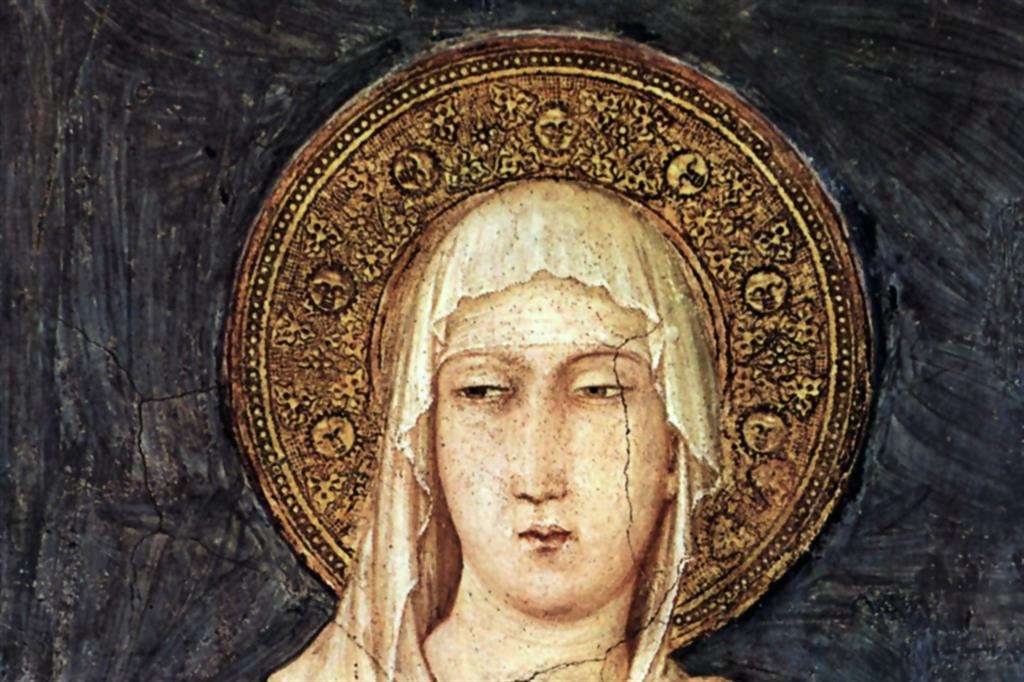
Jacopa Frangipane de’ Settesoli, also known as “frate Jacopa” (Rome, circa 1190 Assisi, circa 1239) in a painting by Simone Martini. The woman is recognizable by the seven suns that surround her head – WikiCommons
In the lower basilica of San Francesco, in Assisi, she is buried next to the first followers of the Poverello and a few meters from him. The wealthy Jacopa Frangipane de’ Settesoli met him in 1210 in Rome when she was just twenty years old, already married for five years and mother of two children, and she was fascinated by her evangelical preaching. She helps him find accommodation with the Benedictines of Ripa Grande and obtain an audience with Pope Innocent III. «He loves and continues to walk»: the writer Lucia Tancredi imagines that the saint told her in the book Jacopa dei Settesoli. Francesco’s rich friend (page 344, euro 17.90), in bookshops for Città Nuova which had already published in 2006 I Monica. The Confessions of Augustine’s Mother and three years after the biography of the mystic Hildegard. Power and grace. In these pages the author reconstructs, assuming the first person and the gaze of Madonna Jacopa, her friendship with the patron saint of Italy. And it does so by oscillating between the historical, literary and poetic register, immersing readers in medieval atmospheres but always keeping their eyes focused on that special relationship that unites two apparently distant worlds – a young noblewoman and a religious mendicant – in the name of faith and love for God. And it was not only the future saint who inspired her, but vice versa he founded the order of the “Brothers and Sisters of Penance” in 1221 for those laymen who, like Jacopa, wanted to follow her lifestyle while remaining world: it is the current Franciscan third order. The charism of Assisi is inclusive and ranges from men to women (think of the second Franciscan order, of which Saint Clare wrote the Rule, the first woman in the world to do so), up to rich or poor believers. It is enough that the orientation, the compass, remains the Gospel. “Since I met Francesco, I’ve begun to look at things from the perspective of the huts,” reflects Jacopa, whom he affectionately dubbed “Brother Jacopa.” She will be called with a letter to her bedside and described as “servant of the Most High”, “dearest”: Francis warns that her death is near and wants her together with the friars at the Porziuncola. It is a tender and very human passage, in which in addition to the cloth to wrap her body and the candles she asks for the sweets «that you used to give me when I was ill in Rome». The writer adds: «You prepared them even before I asked, because this is our love, made up of silent words». And in this silent communion, which will make Madonna Jacopa witness to Francis’ passage to eternal life on the night between 3 and 4 October 1226, all those lay people who over the centuries have accompanied the journey of the friars with sincere friendship and uninterrupted prayer are included, in an enlarged fraternity that their founder had dreamed of and desired, in an embrace with all creatures. Jacopa is an important forerunner that this volume allows us to imagine: to the few historical details that remain of her, to the works of charity accomplished in her existence (she will die in Assisi in 1239, at the age of 49), Lucia Tancredi adds those literary pieces that restore an all-round figure of a woman who, widowed and after the saint’s death, left power to her son Giovanni. Francesco was canonized in record time, less than two years after his death, on 16 July 1228, and in 1231 she obtained the transfer of the hospital of San Biagio in Rome from the Benedictines, transforming it into the convent of San Francesco a Ripa thanks to the help of Pope Gregory IX.
Spirituality. Jacopa de’ Settesoli: wealth followed the Poverello

